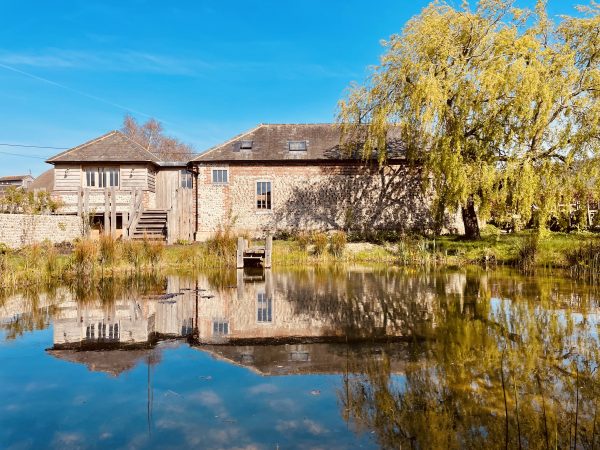 The Byre is a 13th C. grade II listed flint barn. It’s restoration and conversion and it’s surrounding landscaping and pond were awarded a Sussex Heritage Trust 2023 award in the small residential category.
The Byre is a 13th C. grade II listed flint barn. It’s restoration and conversion and it’s surrounding landscaping and pond were awarded a Sussex Heritage Trust 2023 award in the small residential category.
This is the story of the restoration of the pond and it’s surrounding landscape into a variety of different wildlife habitats, and connecting the Byre and it’s new extension to the new garden with steps and paths using local materials, in keeping with the historic building and the South Downs National Park environment.
Learn more about the Sussex Heritage Award.
The Byre is a luxury retreat set in the heart of the South Downs National Park. Find out more.
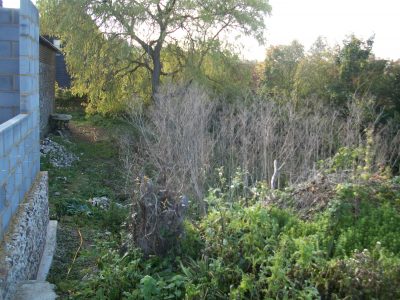
view from Brye of over grown pond
Client’s Brief: The clients had been give planning permission to convert the Brye/Cattle shed into a dwelling and part of the planning permission was that the disused farm pond behind the Brye should be restored, using natural materials where possible and be planted with native plant species to encourage wildlife back into the pond garden, to produce a functioning habitat. There should be access from the new car park on the higher level above the flint retaining wall and access from the back door of the Brye, as well as the 1m wide side access. The pond and it’s planting should sit the Brye into it’s restored landscape, with a simple jetty out over the water.
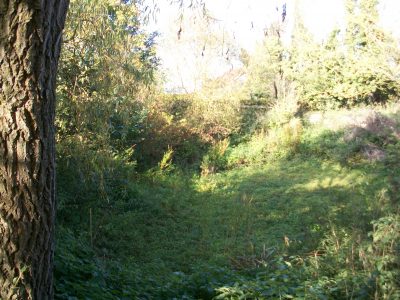
before designing beings
Site: The clients had moved into a converted barn next to the Brye, the previous owners had converted the barn and a lot of the rubbish had been dumped in the farm pond. The site was completely over grown, with an existing planted weeping willow tree and a number of other self sown saplings, including hazel, field maple and elm, which sadly was diseased, crowding the edge of the pond. The main body of the pond did not hold water any more despite the high water table and was filled with a lot of building rubble and the side boundary was edged by a ruinous flint wall.
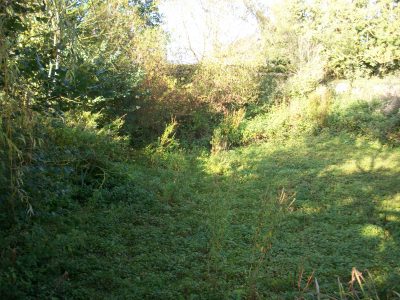
view of pond from Brye before landscaping begins
Site constraints: The access was challenging being only 1m wide by the side of the Brye. The Willow although a beautiful tree, had it’s roots growing into the pond. No one had any idea how much rubbish was in the pond and how deep it may be. The high water table was a great concern, and would need to be taken into account. The Brye was a good 1.5m above the level of the pond, and in places the pond edge was very close to the boundary, not allowing much room to grade slopes down to the waters edge. The pond had to be restored to the exact same shape and over all depth. The natural constraints which were put on the project by South Downs National Park, we had to make sure we used natural materials, that the disturbance of existing wildlife would be to the minimum and they had a tight rein on the native planting that could be used.
Designing the pond. The first thing to do was to have an ecological survey carried out over 6 weeks to assess what wild life was present. Also a topographic in-depth survey was carried out. Armed with this information and with the clients brief, I was able to start work on designing the project which would still have to go back to the planners. Luckily for the clients there was sadly not much in the way of wildlife present, including the rare great crested newt which would have been amazing to have in your garden, but would have made for an impossibly expensive build.
The first challenge was the difference in height, round the Brye and getting access to the garden. So a set of brick steps lead down by the flint wall from the car park to a Broadwalk, with a set of steps up from the Broadwalk to the back door and a set of steps down onto the sloping lawn round the pond. Wood was used as a Broadwalk as the client particularly liked this material and a wooden walkway had passed the initial planning that had been put in years before by the previous owners. Sadly planners change and so do tastes, so it was rejected so a new design of a brick path with brick steps into the garden was produced.
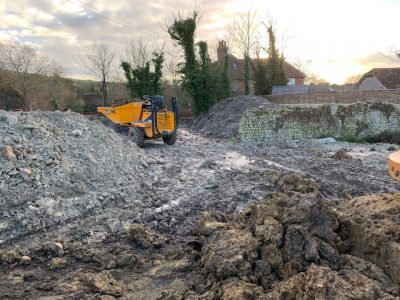
rubble etc. removed from pond.
The next was concern about the high water level and the Willow. SDNP planning said they were happy for natural ponds to now have a butyl liner over spread with puddling clay and this is how they restore dew ponds on the Downs. The Willow, was going to have to be root pruned and then have some very strong root barrier placed round the roots on the pond side of the tree. Under pond drainage was need with a pump, to remove excess water from under the liner, this was managed with a pump and floatation devise to keep the water table level below the liner level.
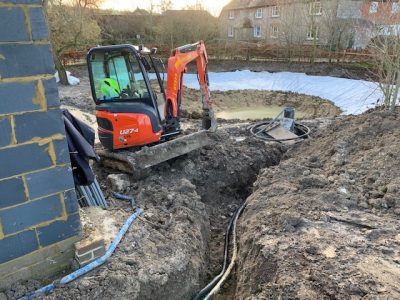
putting pipe work in.
Restoring habitat to the pond. A wide planting shelf of up to 2m wide was to be constructed all the way round the pond and would gentle slope down so there could be different depth planting zones for the aquatic plants. A large bog garden area lined with puddling clay was created so that it could become an over flow area for water above the pond water level, particularly in the winter months when there was more rain. Areas of native shrub and understory planting were designed round the pond to create different habitats. The areas of grass were to have different moving treatments, with different grass lengths and some kept long through the winter months, to produce as many different habitats as possible. Piles of cut grass would be left through the winter months for invertebrates to hibernate and small mammals. The whole ethos of the design was to create new and varying habitats.
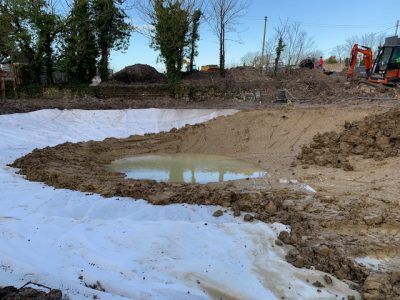
spreading clay liner
The clients enjoyment in the new garden: In amongst all the thoughts on native planting and natural build processes, it was important to remember the clients, their family and their clients who would be using the garden, so they could all interact with it fully. Hence the wooden jetty, leading through the bog planting over the water. Also meandering grass paths cut through the meadow grass, leading down to the waters edge and round the blog planting. There will be simple seats set in quite niches where the pond life can be enjoyed.
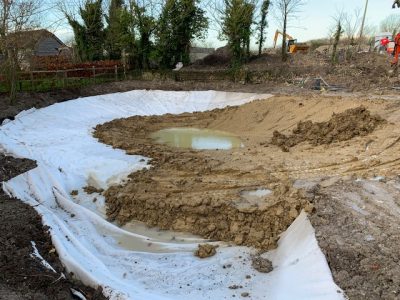
puddling clay spread over the pond surface.
Landscaping: It was decide to use a SDNP recommend pond contractor for this very specialist project. It was important that the project was carried out over the dormant season, for both the existing plants and any wildlife, also so the winter rains could naturally fill the new pond.
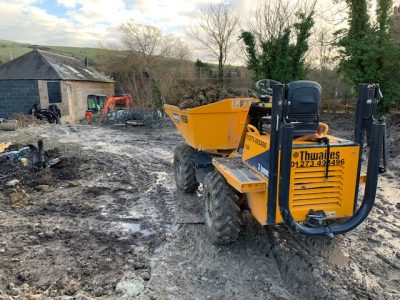
moving soil round the site
Access was the first problem to be solved. It was decide that a large ramp in earth and hard core should be created, over the top of the flint wall. This allowed the empty top garden to be used as a working area and gave access for the large machines needed to clear the pond and start the processes of re-shaping and grading the pond.
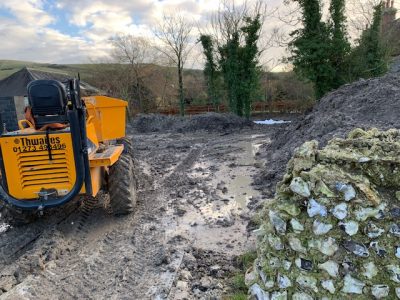
moving soil around in the working top garden
Once the shape had been produced,all the pipe work needed to be put in place, this was not just the under pond drainage and pump but also a large rain harvest tank which was to collect water from the roof of the Brye and would be used to top up the water level in the pond.
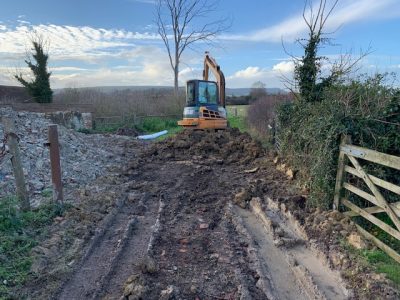
soil and rubble from the pond being stacked.
Next the underlay, butyl liner were to go in, next was 80 tones of pudding clay. Unfortunately as this work started what had been a record hot summer and very dry autumn gave way to some very heavy rain, just as the clay arrived, the site turned into a very muddy and difficult place to work.
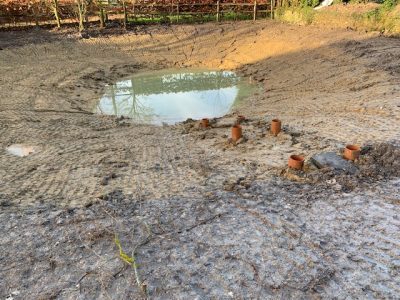
putting foundation stones in for the jetty.
As the pond team struggled on they finally managed to finish the landscaping of the pond including putting the large sandstone foundation stones in place ready for the green oak jetty. The jetty had been build to an Arcadia design by a skilled set of carpenter, with no metal fixings below the water level.
Now the pond was ready to fill up and ready for May planting.
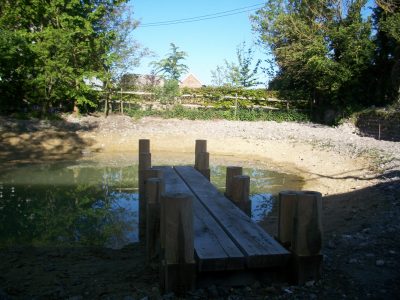
finished pond
May Pond Planting: The pond was planted in mid May right at the start of the pond planting season. All the native plants arrived from a local trade nursery that specialises in growing their own water plants. The pond had been pumped out a few days before hand so the water level was just below the planting shelf.
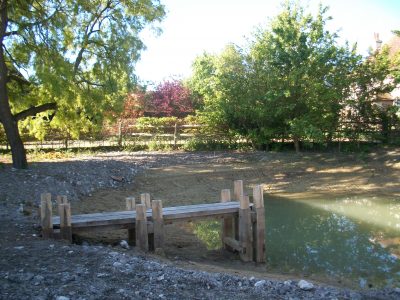
pond, with water level dropped ready for planting.
The first plants to be planted were the lilies and other floaters, that had been planted in aquatic baskets. The baskets are lowered to the pond bottom on ropes. The next to be planted are free-floating floaters, these are plants like water soldiers, these are thrown out into the water round the edge of the pond and will float around the surface moving on a gust of wind.
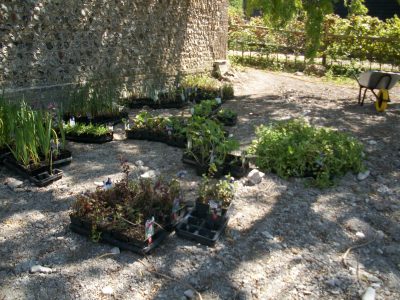
pond plants arrive.
Then the all important oxygenators are planted, these are in bunches with small metal weights on, again you walk round the pond throwing them in, slowly they sink just below the surface.
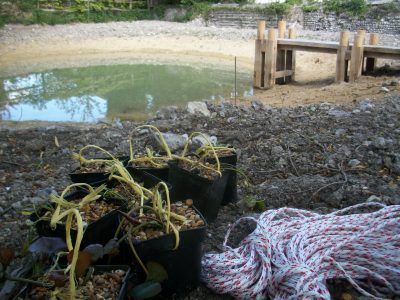
lily baskets ready for planting with planting ropes.
The next plants to be planted are the marginal aquatics, the planting areas were marked out on the planting shelf round the pond. The shelf may be nearly 2m wide in places but the plants were to be planted on only 1.5 m wide sections of the shelf and in blocked areas. Native pound plants are very vigorous and can be invasive, so they would easily spread over time.
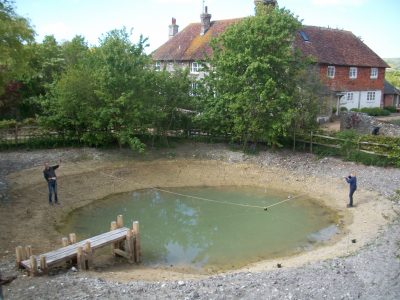
planting floaters in baskets.
Then each area of marginal planting is set out in accordance with the planting plan, and the plants, planted. Each evening as these are water plants and need more water, all the newly planted plants were watered with a sprinkler and the remaining plants waiting to be plated which were in the shed of the willow, to keep them damp at all times.
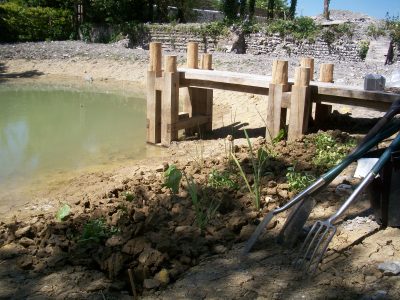
planting marginal aquatics
Once all the marginal plants were planted, the bog garden was set out and planted.
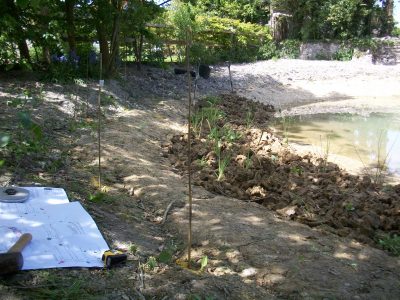
marginal aquatics
Now the pond is being filled up, and all the clients have to do is watch the new plants grow and breath live into their newly restored farm pond over the coming growing season.
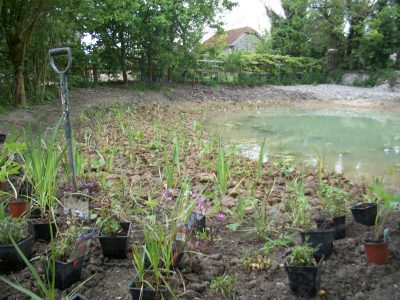
planting bog plants
If you would like help and advise on creating a wildlife pond, I know just the person to help you! Give Emily a ring on 01273 470753, to discuss all your pond needs.
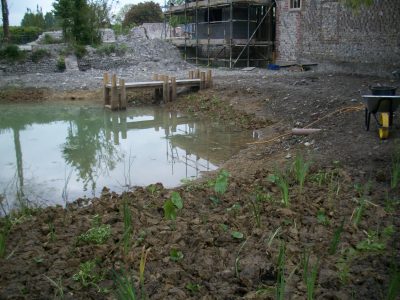
pond planting completed.
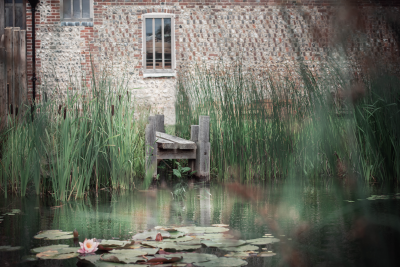
The pond after a few years, the planting has now settled in.
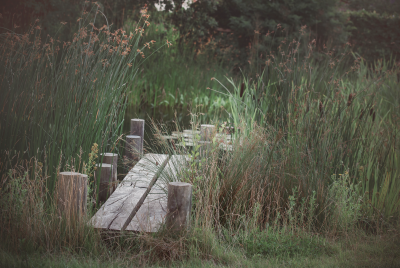
The jetty after a few years of growth, leading out through the pond rushes to the waters edge.

